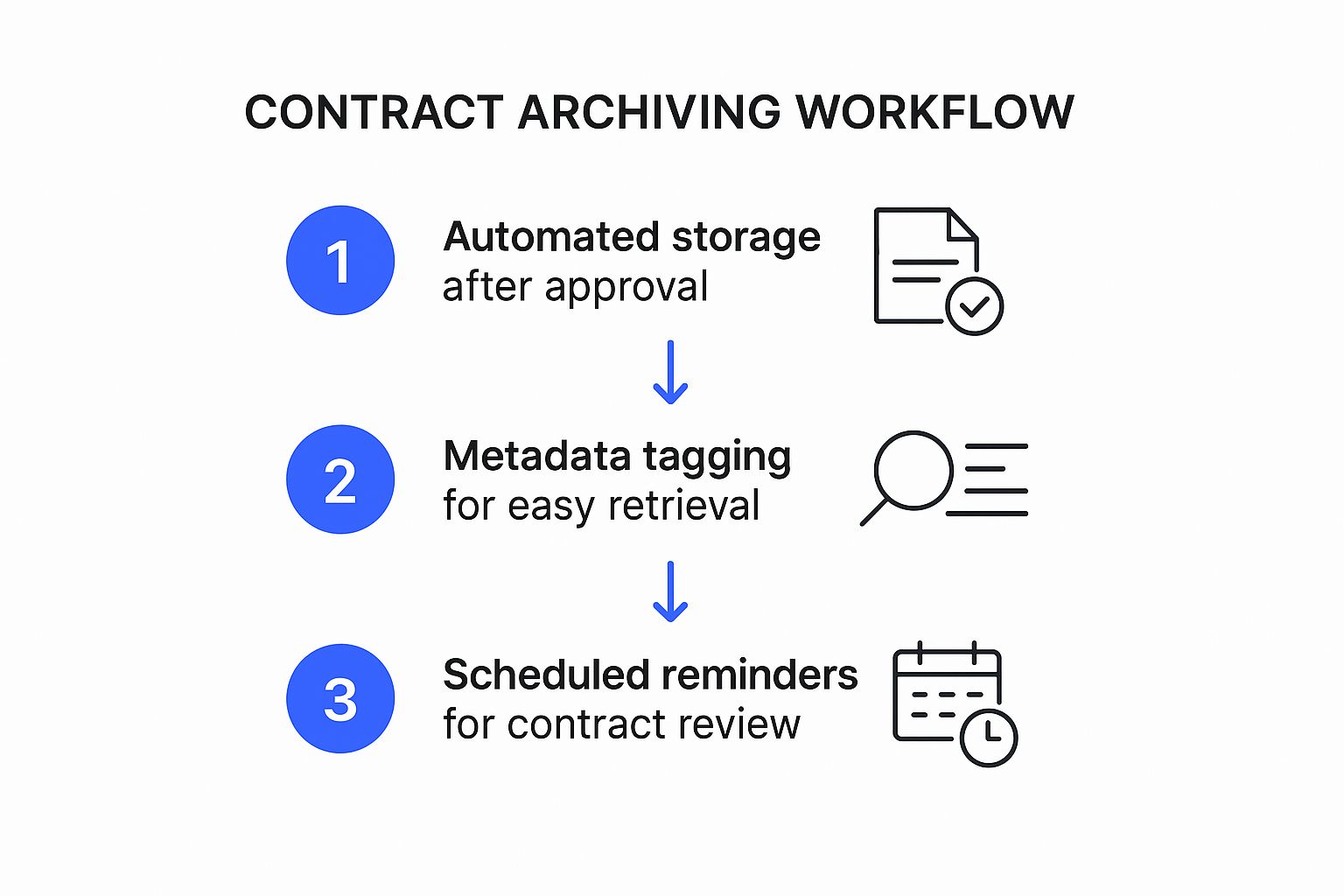
Think of your contract process for a second. Is it a well-oiled machine, smoothly moving deals from one step to the next? Or is it more like a chaotic workshop, where important agreements get lost, delayed, or just plain forgotten?
Contract workflow management is the system you build to create that well-oiled machine for your agreements. It’s more than just software—it's the entire sequence of steps, rules, and automations that guide a contract from its initial request to its final renewal. It's the strategic playbook that turns a messy, manual process into a controlled, efficient, and transparent operation.
From the moment someone asks for a new contract until it’s signed, stored, and eventually flagged for renewal, a solid workflow ensures nothing falls through the cracks. It clearly defines who needs to do what, by when, and in what order. This isn't just about shuffling papers; it’s a modern approach to business that goes way beyond simple document storage.
The Core Stages of a Contract Workflow
To really get a handle on this, it helps to see the contract's journey as a series of distinct phases. Each stage has a clear purpose, moving the agreement forward while keeping everything compliant and minimizing risk. This structured path is what separates smart contract management from disorganized, ad-hoc messes.
The table below breaks down the essential stages you'll find in almost any contract workflow.
| Stage | Key Activity | Primary Goal |
|---|---|---|
| Request | A stakeholder formally asks for a new contract. | To capture all the necessary details and justify the need for the agreement. |
| Drafting | The initial version of the contract is created. | To produce a clear, compliant, and accurate document using approved templates. |
| Negotiation | Internal and external parties review and propose changes. | To reach a mutually agreeable set of terms while protecting business interests. |
| Approval | The final draft is sent to key decision-makers for sign-off. | To get official authorization from all required stakeholders before execution. |
| Execution | The contract is signed by all parties. | To create a legally binding agreement and formalize the business relationship. |
| Post-Execution | The signed contract is stored, and its obligations are tracked. | To ensure compliance, monitor key dates, and manage the agreement's full lifecycle. |
Seeing it laid out like this makes it clear: this isn't just an administrative checklist; it’s a vital business function. The tools and systems that power these workflows have become central to how modern companies operate. In fact, the global market for contract management software was valued at around USD 2.83 billion and is expected to hit USD 5.65 billion by 2030, growing at a rate of about 12.7% each year. This boom shows just how widely departments like legal, sales, and finance are adopting automation for these critical processes. You can dig into the full contract software market analysis from Grand View Research to see how its role is expanding.
By defining each step, you get rid of the guesswork. Team members know exactly what their role is, what comes next, and where every contract is at all times. This kind of visibility is the first, most important step toward regaining control over your business agreements.
The True Cost of a Disorganized Contract Process

When a contract process falls apart, the damage isn't small or contained. It sends ripples through the entire company, creating hidden costs that go far beyond simple frustration. These aren't just administrative headaches; they're real business setbacks that can stall growth, tarnish your reputation, and expose you to serious financial and legal trouble.
Picture this: your sales team has spent months landing a massive deal. They finally get a verbal "yes," but then the contract disappears into a legal black hole for weeks. It’s a mess of endless email chains, random document versions saved in different folders, and zero clarity on who needs to approve it next. By the time the final agreement is ready, the client has moved on. The deal is dead.
This isn’t just a bad dream. It’s a reality for businesses that lack effective contract workflow management.
The High Price of Inefficiency
The most obvious cost of a chaotic process is the lost opportunity. When contracts drag on, momentum stalls, and you leave the door wide open for competitors. But the financial bleeding doesn't stop there—it touches nearly every corner of the business. Manual processes aren't just slow; they’re a breeding ground for human error.
Think about these all-too-common scenarios and their direct financial fallout:
- Missed Renewals: A key software subscription auto-renews at a higher price because no one was tracking the termination date. Now you're stuck paying for another year of an overpriced or unneeded service.
- Compliance Penalties: A forgotten clause in a client agreement leads to a regulatory breach. The result? Steep fines and a soured relationship with a key partner.
- Unfavorable Terms: A negotiation is rushed because of a disorganized process. You end up agreeing to bad payment terms or risky liability clauses that come back to bite you down the road.
Each of these examples points to a failure of process, not people. Relying on shared drives and email threads for something as critical as a contract is like trying to navigate a ship through a storm with a paper map. You might get lucky, but the risk of disaster is way too high.
A study by World Commerce & Contracting found that poor contract management can cost companies up to 9% of their annual revenue. For a business pulling in $10 million, that's a potential $900,000 loss every single year from mistakes that could have been prevented.
Erosion of Trust and Relationships
Beyond the direct hit to your bottom line, a disorganized contract process slowly chips away at trust, both inside and outside your company. When different departments are working from different versions of a contract, it creates internal friction and silos. Sales might promise something that legal can't approve, sparking conflict and more delays.
This internal chaos always spills over into your external relationships. A potential partner who endures a slow, confusing, and unprofessional contracting experience will start to doubt your company's ability to deliver on its promises. It screams disorganization and a lack of attention to detail—two qualities nobody wants in a business partner.
Imagine a new vendor trying to start a partnership with you. If their first interaction is a two-week delay just to get a standard NDA signed, their confidence in your operational skills will plummet. This is where a well-oiled contract workflow management system becomes a genuine competitive advantage. It ensures every interaction is smooth, professional, and efficient, building a strong foundation for a lasting business relationship from the very first document.
Without it, you're not just managing contracts poorly; you're actively undermining your company's credibility.
The Building Blocks of a Powerful Contract Workflow

A powerful contract workflow management system doesn't just appear out of thin air. It’s built from several interconnected pillars, each one reinforcing the others to create a process that’s both resilient and efficient. Getting a handle on these core components is the first step toward building a system that cuts through the chaos and puts you back in control.
Think of it like building a house. You can't just throw up some walls and hope for the best. You need a solid foundation, a sturdy frame, and integrated systems like plumbing and electricity. In the same way, a good contract workflow needs specific, foundational elements working together in harmony.
Let's break down the essential building blocks that make a workflow truly world-class, moving past theory to see how they actually function in a real business.
A Centralized Contract Repository
The most fundamental piece of the puzzle is a centralized repository. This is your single source of truth for every single contract across the company. Gone are the days of agreements scattered across individual hard drives, buried in email threads, or lost in various cloud folders. Instead, every document lives in one secure, searchable place.
This isn't just about being tidy; it's about gaining control and intelligence. When all your contracts are centralized, you get complete visibility. You can instantly find any agreement, check its status, and see its entire history without a frantic, time-wasting search. Effective legal document management starts with knowing exactly where everything is.
This central hub solves several critical problems at once:
- Version Control: It wipes out the risk of people working from outdated drafts because everyone is accessing the same master version.
- Security: You can set specific permissions, making sure only authorized people can view or edit sensitive agreements.
- Accessibility: Key stakeholders can find what they need on demand, from anywhere, without having to ask around.
Intelligent Automation and Templates
Once you have a central home for your contracts, the next layer is automation, and it usually starts with pre-approved templates. Instead of drafting every new NDA or sales agreement from scratch, your team begins with a standardized template that’s already been vetted by legal. This immediately creates consistency and lowers risk.
But the automation goes much further. A modern contract workflow uses rules to push documents along automatically. For instance, when a sales rep creates a contract from a template, the system can pull customer data directly from your CRM and auto-populate the fields. This doesn’t just save time—it dramatically cuts down on manual data entry errors.
By automating routine drafting and data entry, you free up your legal and sales teams to focus on high-value, strategic work instead of administrative busywork. That’s a direct boost to productivity.
Transparent Approval Pathways
How many times has a contract stalled because nobody knew who was supposed to sign off on it next? A core part of effective contract workflow management is creating clear, automated approval pathways.
These are pre-defined routes that a contract has to follow. For example, you can set a rule that any deal over $50,000 must automatically go to the CFO for approval right after the legal team gives it the green light.
This creates total transparency. At any given moment, anyone can see:
- Whose desk the contract is currently on.
- How long it's been sitting there.
- Who the next person in the approval chain is.
This level of accountability breaks down communication silos and finally puts an end to the "black hole" where contracts seem to vanish. It speeds up the whole deal cycle by making sure the agreement is always moving forward to the right person.
Seamless Software Integrations
Your contract process doesn't operate in a bubble. It's connected to other vital business systems, like your CRM, ERP, and e-signature platforms. A truly powerful workflow integrates smoothly with these tools to create a fluid, end-to-end process.
For example, an integration with a tool like DocuSign or Adobe Sign allows for one-click sending for execution as soon as all the approvals are in. The signed document is then automatically filed back into your central repository. This gets rid of manual steps, speeds up execution, and keeps the entire lifecycle inside a single, controlled environment.
The market for these integrated systems is growing fast. The contract lifecycle management (CLM) software market was valued at around USD 1.1 billion and is projected to expand at a compound annual growth rate of 12.9% through 2034. This growth is fueled by the undeniable need for automation and efficiency in every industry. You can explore more data on the expanding CLM software market from The Business Research Company.
How to Implement a Modern Contract Workflow System
Alright, let's get practical. Moving from theory to a real-world solution requires a clear plan. Implementing a modern contract workflow management system isn't just about picking new software—it's about rethinking a core business process from the ground up. When you break it down into manageable stages, you can shift your team from putting out fires to proactively managing agreements.
The journey starts with an honest look in the mirror. You can't fix a process you don't fully understand. A successful rollout is built on a foundation of clear-eyed assessment, concrete goals, and a smart, phased implementation. Let's walk through the steps to bring an effective system to life in your organization.
Stage 1: Start With a Process Audit
Before you can build a better workflow, you need to map out the one you have now. Think of this audit as a fact-finding mission to uncover every single touchpoint, delay, and frustration in your current contract process. Don't rely on what you think happens; get the real story.
Grab a whiteboard or open a digital canvas and trace the journey of a contract, from the initial request all the way to filing it away. Ask the tough questions to find the bottlenecks:
- Where do contract requests actually come from?
- Who is responsible for drafting the first version?
- How many people really need to review and negotiate it?
- Where does everything grind to a halt?
- How are signed contracts stored, and can anyone find them later?
This exercise will visually expose the hidden cracks in your system. You might discover that every contract gets stuck waiting for legal review, or that sales reps are using outdated templates that cause problems for everyone else down the line. These are the golden nuggets of insight you'll use to design a new workflow that solves your actual problems.
Stage 2: Define Your Goals and Success Metrics
Now that you have a clear picture of your current state, you can define what "better" actually looks like. Vague goals like "improve efficiency" won't cut it. You need specific, measurable objectives that will not only guide your decisions but also prove the project's value later on.
Think in terms of tangible outcomes. Your goals for a new contract workflow management system might sound something like this:
- Reduce contract cycle time by 30% within six months.
- Eliminate the use of unapproved contract templates entirely.
- Ensure 100% of executed contracts are logged in the central repository within 24 hours of signing.
These key performance indicators (KPIs) become your benchmarks. They give you a clear way to track progress and show leadership the real-world impact of your new system.
A well-defined goal is your North Star for the entire project. It keeps the team focused on results, not just activities, and helps you prioritize what really matters when you're choosing a tool.
Stage 3: Choose the Right Technology
With your goals set, it’s time to find the right tool for the job. The market is full of options, from simple document storage to comprehensive contract lifecycle management (CLM) platforms. The right choice for you depends entirely on the goals you just defined.
You don't need a sledgehammer to crack a nut, but you also don't want to bring a screwdriver to a demolition job. The key is to find the right fit for your company’s needs, scale, and budget.
Comparing Contract Management Solution Types
This table breaks down the main types of software solutions to help you figure out where to start your search.
| Solution Type | Best For | Key Strengths | Potential Limitations |
|---|---|---|---|
| Document Management Systems | Teams needing basic storage and organization. | Centralized repository, version control, access permissions. | Lacks workflow automation, approval tracking, and analytics. |
| E-Signature Platforms | Businesses focused on speeding up the execution stage. | Legally binding signatures, simple signing workflows. | Limited pre-signature capabilities like drafting and negotiation. |
| Standalone CLM Software | Companies needing a dedicated, end-to-end solution. | Full lifecycle automation, deep analytics, robust integrations. | Can be more complex and costly to implement and maintain. |
| Integrated Platform Features | Organizations that want contract features within their CRM or ERP. | Seamless data flow with existing systems. | May not have the depth of a specialized CLM tool. |
Carefully weigh these options against your audit findings and goals. Choosing a tool that aligns with your real-world needs is the most critical decision you'll make in this process.
Stage 4: Design and Roll Out Your New Workflow
Once you’ve picked your technology, you can start mapping out the future. Using the insights from your audit and the features of your new software, design the ideal workflow. This is where you automate approval chains, build out your new template library, and connect the tool to other business systems like your CRM or accounting software.
Trying to switch everyone over at once—a "big bang" rollout—is a recipe for chaos. A phased approach is almost always better:
- Start with a pilot group: Test the new workflow with a single, tech-friendly team, like sales or procurement. They can work out the kinks.
- Gather feedback: Listen to what your pilot users have to say. Their input is invaluable for fixing issues before you go company-wide.
- Train your teams: Don't just show people how to use the software. Explain why the new process is better for them and the business. Good training is the key to getting people on board.
This methodical approach makes for a much smoother transition and helps you build momentum as more people see the benefits. As teams get comfortable, you can gradually expand the system to handle more departments and more complex agreements.

This visual highlights a key benefit of a modern workflow: what happens after the contract is signed. Automation transforms post-execution management from a manual chore into a strategic advantage, ensuring documents aren't just stored but are turned into intelligent assets with active reminders and searchable data.
Best Practices for Long-Term Workflow Success

Getting a new contract workflow management system up and running is a big win, but it's not the finish line. The real payoff comes from treating your workflow like a living system—one that needs regular attention to stay in top shape. A "set it and forget it" mindset is a recipe for a process that slowly but surely becomes outdated and out of sync with your business.
To prevent that from happening, you need to build a culture of continuous improvement. It’s all about creating good habits that keep your workflow running smoothly, securely, and aligned with your goals. These practices ensure your system isn't just a temporary fix but a lasting advantage.
Regularly Review and Refine Your Templates
Your contract templates are the starting point for every new agreement, but they shouldn't be set in stone. Business needs shift, regulations change, and you learn something new from every negotiation. That’s why you have to revisit your template library from time to time.
Make it a habit. Set a recurring schedule—maybe quarterly or twice a year—to go through your most-used templates. Ask some hard questions:
- Is the language still current? Does it reflect the latest legal standards and your company's policies?
- Are we seeing the same redlines over and over? If the other side consistently pushes back on certain clauses, it might be time for a rethink.
- Can we make this simpler? Hunt for opportunities to cut jargon or streamline sections to get to "yes" faster.
This kind of proactive maintenance keeps your starting documents sharp, which means shorter negotiation cycles and less risk from old, irrelevant terms.
Enforce Clear Ownership and Accountability
A workflow without clear ownership is doomed to fail. Every single stage, from the initial request to post-signature renewals, needs a designated owner who is responsible for keeping things moving. When nobody knows who’s up to bat, contracts just sit there, and deadlines get blown.
Ambiguity is the enemy of an efficient workflow. When people aren't sure who is responsible for the next step, the default action is often no action at all, leading to costly delays.
Assign a specific person or role to each phase. For instance, the account manager owns the request, the legal team takes the lead on drafting, and the finance department handles tracking obligations after the deal is signed. A good contract workflow management platform makes this easy by letting you assign tasks visually and sending out automated reminders, so everyone knows exactly what’s on their plate and when it's due. Our guide on the essentials of a contract management workflow digs deeper into the importance of having clear roles.
Leverage Analytics for Continuous Optimization
Your workflow software is much more than a digital filing cabinet; it’s a goldmine of data. The analytics and reporting features are your secret weapons for finding hidden bottlenecks and opportunities to get better.
Dive into the numbers to answer strategic questions:
- Which contract types always seem to take forever to get approved?
- Where are the most common logjams in the approval chain?
- Are certain team members getting buried under review tasks?
This demand for data-driven insights is a big reason why the global contract management software market, valued at around USD 3.1 billion, is expected to skyrocket to USD 9.1 billion by 2032. As you can see in the latest market projections on GlobeNewswire, companies are pouring money into tools that help them close deals faster and stay compliant. Use your own data to make smart adjustments, rebalance workloads, and keep tweaking your process until it’s a well-oiled machine.
Common Questions About Contract Workflows
As you start exploring contract workflow management, a few questions always seem to pop up. Getting straight answers is the key to connecting the dots and seeing how these systems actually work on the ground. Let's tackle some of the most common questions we hear to clear up any confusion.
These answers should help bridge the gap between the big ideas and what you'll actually be doing day-to-day, making it easier to see how a solid workflow can help your business.
What Is the Difference Between Contract Management and Workflow Management?
This is a fantastic question because the two concepts are so closely linked, but they aren't the same thing. I find it helps to think of it like building a house.
Contract management is the entire architectural blueprint. It’s the master plan covering everything from getting the initial permits (the contract request) to the final inspection (renewal or termination). This is where you define your overall policies, goals, and how you'll handle risk.
Contract workflow management, on the other hand, is the construction crew with their daily schedule. It’s the specific, nuts-and-bolts process—the set of automated steps and tasks—that moves the materials around and actually gets the house built according to the blueprint. It’s the engine that brings the strategy to life.
To put it simply, contract management is the "what" and the "why" of your agreements. Contract workflow management is the "how"—the operational engine that executes the plan and pushes a contract from one stage to the next.
How Can Small Businesses Benefit from Contract Workflow Management?
There's a common myth that these kinds of robust systems are only for huge corporations with entire floors of lawyers. Honestly, small businesses often have the most to gain. For a small team, one bad contract or a single missed deadline can have a much bigger, sometimes even devastating, impact.
A well-designed workflow brings some huge wins for a smaller company:
- Saves Precious Time: Automating repetitive tasks frees up your key people—often the founders themselves—to focus on growing the business instead of getting buried in paperwork.
- Reduces Critical Risks: It lowers the odds of human error, like forgetting to cancel an expensive subscription before it auto-renews or using an old template with bad terms. A clean process is the first step in any good contract risk assessment strategy.
- Boosts Professionalism: When you can turn contracts around quickly and without hiccups, you look more organized and reliable to clients, partners, and investors.
With so many affordable and scalable tools built just for smaller teams, powerful contract workflow management is no longer out of reach. It levels the playing field, letting small businesses operate with the same kind of control and efficiency as the big players.
What Is the Best First Step to Automate Our Contract Process?
The best first step is also the simplest one: map out your current process. Seriously. Before you even look at software or think about automation, you have to get an honest picture of how things work right now.
Grab a whiteboard (a real one or a digital one) and trace the journey of a typical contract in your organization from start to finish. Make sure to get the people who actually do the work involved. Ask them to walk you through every single step, from the moment a request is made until that signed document is finally filed away.
You will be amazed at what you uncover. This exercise shines a bright light on your biggest pain points. You might discover that approvals always get stuck with one person, or that your sales team is using three different versions of the same proposal template.
This simple audit gives you a clear diagnosis of what's actually broken. Once you know the specific problem, you can start looking for a solution—whether that’s a new procedure or a new technology—that directly fixes it. Don't start by shopping for a tool; start by understanding your problem.
How Does AI Change Contract Workflow Management?
Artificial intelligence (AI) is like a supercharger for your workflow. It doesn't just make it automated; it makes it intelligent. AI can now handle tasks that used to require a trained human eye, completely changing how you interact with your agreements.
Here’s where AI adds a new layer of efficiency and insight:
- Automated Data Extraction: Instead of someone manually typing key details from a contract into a spreadsheet, AI can instantly read a document and pull out critical info like effective dates, renewal deadlines, party names, and payment terms. This kills manual entry errors and saves a ton of time.
- Intelligent Risk Analysis: You can train AI to scan agreements for non-standard or risky language. It can flag clauses that are different from your approved templates, giving your legal team a heads-up about potential problems before they become real issues.
- Conceptual Search: A normal search finds keywords. An AI-powered search finds concepts. You can ask your contract database to "show me all contracts with unusual liability clauses" instead of just searching for the word "liability."
Suddenly, your contract repository goes from being a passive digital filing cabinet to an active, strategic tool. It empowers your team to make smarter, faster decisions by finally unlocking all the valuable data trapped inside your agreements.
Ready to stop guessing and start understanding your legal documents? With Legal Document Simplifier, you can upload any contract and get a clear, plain-language summary in seconds. Our AI-powered platform highlights key terms, tracks deadlines, and flags risks, so you can make confident decisions without the high cost of legal fees. See how it works at https://legaldocumentsimplifier.com.